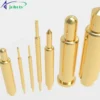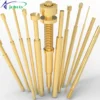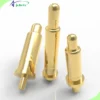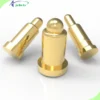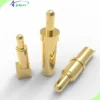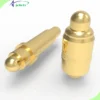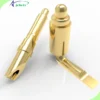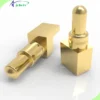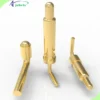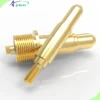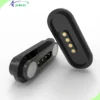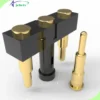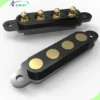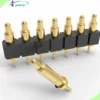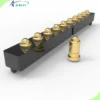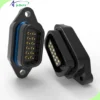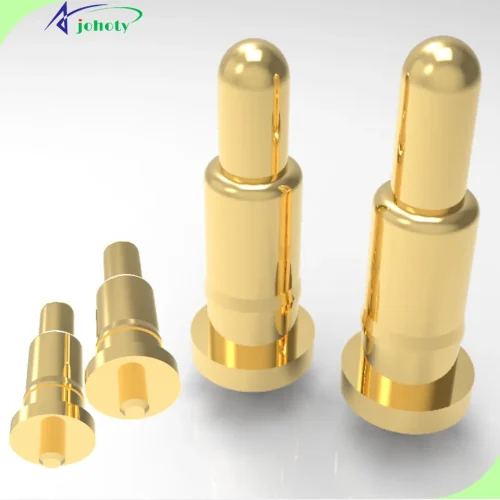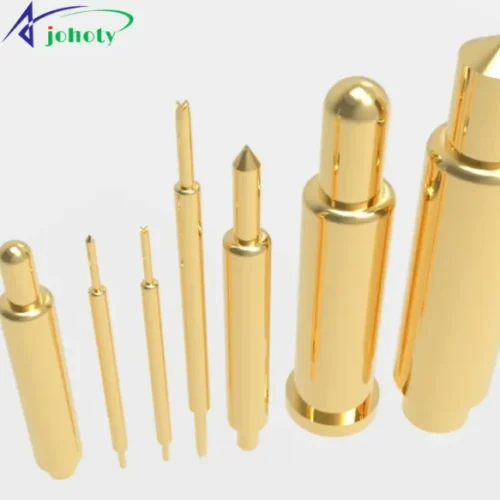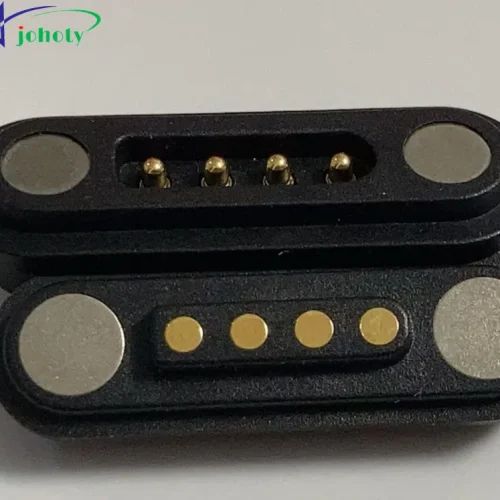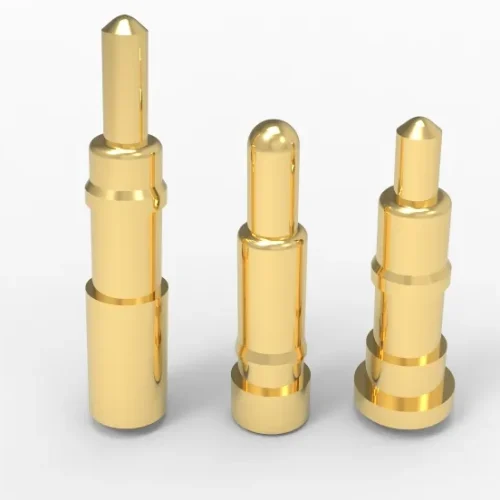Show You What Is a Pogo Pin, Benefits, Applications in Test and Design. For Your Solutions, Projects, Insight, and Practical Tips!
Profile
What is a pogo pin? Some clients call them spring-loaded pins. It is a small, high-precision component used for electronic connections. And, it is popular in electronics innovation and manufacturing because of its unique design and reliability. It consists of a spring, a moving plunger, and a fixed barrel. This allows it to provide a stable, reliable electrical connection when compressed.
The Pogo Pin always keeps a stable performance after working for a long time. Therefore, it is very suitable for those fields that approach constant connections and disconnections. Such as charging interfaces, data transfer interfaces, and test and measurement equipment. Its high level of reliability and durability stems from its internal high-quality spring. Which resists vibrations and shocks while ensuring long-lasting electrical contact.
Importance
Its importance lies not only in its flexibility and adaptability but also in its physical and electrical properties. It can be engineered into all kinds of sizes and shapes so that it can meet the needs of specific applications. Such as tiny wearables, precision medical devices, and large industrial machinery.
In addition, the Pogo Pin is also especially important to protect those sensitive components well from potential damage. So, it has become one of the indispensable components in various electronic manufacturing or design!
What Is a Pogo Pin? And, How to Work?
It is a small connector to establish a reliable electrical connection. The Pogo Pin is for a wide variety of devices due to its unique mechanical design. In general, the Pogo Pin consists of three main components: the plunger, the spring, and the Barrel. The plunger is usually made of brass, BeCu, or TeCu. It can ensure good electrical contact. The spring provides the necessary pressure to ensure that the plunger makes tight contact with the corresponding contact point. The Barrel protects the spring inside, and it ensures that the plunger is aligned well.
When the Pogo Pin is compressed, the spring is compressed. This allows the plunger tip to come into close contact with the contact surface. Thus, it creates a stable electrical connection. When releasing the pressure, the spring pushes the plunger tip back to its initial position, disconnecting the connection. This allows it to provide a highly reliable and reusable connection for all fields that require constant connections and disconnections.
Pogo Pin
The Pogo Pin has high reliability and durability. Thanks to its springs inside, Pogo Pins can automatically adjust to minor surface irregularities and maintain a stable electrical connection. In addition, Pogo Pins are often made of highly conductive and good corrosion-resistant materials. Such as gold, Pt, Pd, Rh, or nickel alloys. It can further ensure long stability and low contact resistance.
It is often used in electronic test equipment, modular connections, and charging interfaces. As well as wherever reliable and repeatable connections are required. Thanks to their compact dimensions and flexible design, Pogo Pins are particularly suitable for modern electronic devices. Including portable devices, robots, TWS, smartphones, medical devices, etc. Where its space is strictly limited and customers ask for good connection reliability.
Pogo Pin Structure
The Pogo Pin gets its name from its distinctive structural design. Which resembles a jumping pogo stick. This design allows it to provide a stable electrical connection under pressure. Its core construction consists of the following components:
Plunger:
The plunger is designed at one end of the Pogo Pin. It makes contact with the corresponding electrical contact. The shape and material of the plunger ensure a good electrical connection and durability.
Spring:
The spring is assembled in the barrel of the Pogo Pin. It provides the necessary pressure to ensure stable contact between the plunger and the contact point. The spring force directly affects the performance of the Pogo Pin, including contact pressure and durability.
Ball, T-pin:
Steel balls and T-pins, both can increase the current tolerance of the Pogo pin. In general, the plunger with bias is close to the steel ball, then places the T-pin, and finally talks tightly against the T-pin. This construction is far more complex than the normal three-piece construction. But routinely it can withstand currents ranging from 3A to 30A.
Barrel:
A barrel is the outer shell that encases the spring and plunger. It is usually made of high-quality raw materials, for example, brass, Becu, Tecu, SUS, etc. The barrel not only provides structural support and protects the internal components. But it is also responsible for establishing electrical connections to the rest of the device.
Tail Pin:
The tail is the other end of the Pogo Pin and connects to a circuit board or other electrical component. The tail is in a variety of shapes, including soldered, plugged, thread screw, SMT, bending, right angle, etc. This is to meet different applications.
Profiled part:
It also has several valued shapes to suit different performance requirements and actual fields. Such as dustproof and waterproof. Special materials and shapes can increase signal transmission rate and reduce signal attenuation.
Key Features Focused on By Most Electronics Engineers
When electronic engineers design Pogo Pin connection solutions. They often think about all kinds of factors. Engineers need to ensure that the Pogo Pins can meet the expected specific applications. Includes electrical performance, physical dimensions, durability, and cost-effectiveness.
Contact resistance
Low contact impedance means less energy loss. It is critical to ensure efficient signal and power transmission. Many engineers look for Pogo Pins with low contact impedance to ensure a high-quality electrical connection.
Durability
It is the number of connections Pogo Pin can withstand without loss of performance. High durability is important in applications that require frequent mating. This is to minimize maintenance costs and extend product life.
Working current rating
The working current of a Pogo Pin refers to the maximum value of current that it can safely transmit. It is critical to select the proper operating current range. It can prevent overheating and ensure the safe operation of the device.
Spring Force
The spring force affects the contact pressure between the Pogo Pin and the corresponding contact point. It is highly related to the stability of the connection and contact impedance. Proper spring force ensures a good electrical connection while avoiding excessive mechanical damage to the contacts.
Size and Shape
The size and shape of a Pogo Pin determines its suitability for a particular design. Including insertion space constraints and adaptability to the layout of contact points. Engineers always select the most appropriate size and shape based on the applications.
Materials and Plating
Both the material and surface coating have a significant impact on its performance. Including corrosion and wear resistance and electrical properties. Common coating materials include gold, nickel, silver, Pd, Pt, Rh, etc. Each plating has its specific targets and advantages.
Environmental Compatibility
This includes the Pogo Pin’s temperature range, humidity tolerance, resistance to corrosion, and other environmental factors. This is especially important for applications that operate in extreme or changing environments.
Reliability
Combining all of the previous characteristics. Reliability is a comprehensive measure of a Pogo Pin’s ability to consistently meet performance standards over its expected life. Highly reliable Pogo Pins are critical to ensuring stable equipment operation and reducing maintenance costs.
How To Select the Best Pogo Pin?
You can systematically evaluate and select the Pogo Pin that is best suited for your R&D project, ensuring that it meets the technical requirements while remaining cost-effective and in line with the project timeline. The following process can help your make informed decisions.
1. Defining your technical requirements
Current and Voltage
First, consider the rated current and voltage that the Pogo Pin needs to carry. Different Pogo Pins can withstand different currents and voltages. So, when choosing you need to make sure that the Pogo Pin you select will meet your electrical requirements.
Mechanical Dimensions
The diameters, length, working stroke, spring force, and others are critical to ensure good contact and fit. When you select the sizes, you need to think about the assembly space and the need for contact pressure.
Durability
Depending on the application, the Pogo Pin needs to withstand repetitive insertion and removal times. Review the durability metrics of the Pogo Pin, such as the number of life cycles. This can ensure they will meet the demands of long-term use.
Contact Impedance
Low contact impedance can ensure stable electrical performance. When selecting, consider the material and finish of the Pogo Pin, which will ensure a low contact impedance.
Operating Environment
Consider the environments in which the Pogo Pin is. Such as humidity, temperature range, vibration, and corrosive environments. When you select a pogo pin, make sure the selected Pogo Pin can adapt to these environmental conditions.
Mounting Method
The mounting method of the Pogo Pin is also a factor to consider when selecting. Including soldering, press-fit, or threaded fixing. Choosing the right mounting method can simplify the assembly process and increase reliability.
2. Thinking about the application fields
- You need to consider multiple application environmental factors. It is to ensure that the Pogo Pin can keep stable performance under various specific working conditions.
- This includes temperature range, both operating and storage, which is critical for material selection and performance stability.
- Humidity can affect the electrical performance of Pogo Pins and cause corrosion.
- Vibration and shock. It is to avoid connection instability due to vibration or shock.
- Ensure pogo pins can be used in corrosive environments.
- Dust and contamination can affect the reliability of the electrical connection.
- Some situations require frequent plugging and unplugging.
- The design and material selection of pogo pins should take into account the need to minimize the effects of EMI.
- Where there are space constraints, the size and shape of the pogo pin need to suit the requirements of a compact installation.
3. Choosing the right type of Pogo Pin
Different types of Pogo Pins can meet different mechanical, electrical, and environmental requirements. When selecting the right Pogo Pin type, you need to consider the stability of the connection, electrical performance, and physical size limitations. As well as expected service life and environmental conditions.
· Standard cylindrical Pogo Pin
Features: Standard cylindrical design for most general-purpose connection requirements.
Fields: Suitable for most standard electrical connection applications, such as data transfer and power connections.
· High-current Pogo Pin
Features: Designed to carry high currents, usually with a large contact area and optimized internal structure.
fields: Suitable for applications requiring high-current transfer, such as charging interfaces and power connections.
· Micro Pogo Pin
Characteristics: Very small size and diameter, suitable for space-constrained applications.
Fields: Suitable for miniaturized applications such as portable electronics, miniature sensors, and medical devices.
· High durability Pogo Pin
Characteristics: can withstand high-frequency plugging and unplugging times, with reinforced structure and materials.
Applications: Suitable for devices that require frequent connections and disconnections, such as test equipment and modular components.
· Pogo Pin with Guide Function
Features: The Pogo Pin has a guiding structure to help align connections correctly and easily.
Fields: Suitable for applications that require precise alignment, such as precision instruments and high-speed data connections.
· Dust and Water Resistant Pogo Pin
Characteristics: Dustproof and waterproof design to maintain good electrical performance in harsh environments.
Applications: Suitable for outdoor equipment, medical equipment, and any application that may be exposed to a liquid or dust environment.
· Angled Pogo Pin (Bending or Right Angle)
Features: One end of the Pogo Pin is at a right angle or at a specific angle to facilitate layout in limited space.
Applicable fields: Suitable for board-to-board or internal connection of components where a specific angle connection is required.
4. Calculating cost and time
You need to find a balance between the lowest cost and the shortest time. The target is to meet the needs of the project and stay on budget and on schedule.
· Cost estimate
Contact us to get the best quote for Pogo Pins. The cost depends on the size, raw material, quality level, lead time, and coating.
· Time estimation
Agree on delivery times with us to ensure that we can meet the project schedule.
Include the arrival time of the Pogo Pin in the project timeline, taking into account manufacturing and delivery times.
· Customization vs. Standard
Consider whether to go with a customized Pogo Pin or use a standard specification. Customization usually adds cost and lead time, but can better meet project requirements. If the project is time-critical, you can consider using an off-the-shelf standard Pogo Pin to save time.
· Quality and reliability
Ensure that the quality and reliability of the selected Pogo Pin meet the project requirements. Especially for applications in high frequency, high temperature, or high vibration environments.
· Long-term costs
Consider the long-term maintenance and replacement costs to ensure project sustainability.
Advantages And Potential Challenges of Pogo Pin
Advantages
· Reliable connections
Pogo Pin uses pressure to establish an electrical connection. So, it has a highly reliable electrical connection. That is less susceptible to vibration or interference.
· High-Frequency Connections
Pogo Pins are suitable for high-frequency connections. As they are less prone to electrical connection problems caused by frequent connections and disconnections. They are suitable for testing, measurement, and commissioning equipment.
· Compact design
Pogo Pins are often smaller than conventional sockets. This makes them very suitable for designs with limited space. It allows for more compact board layouts.
· Fast Connectivity
It can be quickly plugged and unplugged for applications that require frequent connections and disconnections, reducing connection times.
· Customizability
We can customize Pogo Pins to meet the needs of a project. Including size, shape, material, and electrical characteristics to meet the various special needs.
· Water and Dust Resistance
Properly designed Pogo Pins can be water and dust-resistant. Then, they can still keep good performance in harsh environments.
· High Temperature and High Current Capability
Our Pogo Pins can handle high temperatures and high currents of ≤800A. This makes them suitable for applications requiring high-temperature resistance or high-power transfer.
Potential Challenges
· Design Complexity
Designing a connection system suitable for Pogo Pins requires lots of engineering and design work. Including proper contact pressures, material selection, and connection layout.
· Cost
Customized Pogo Pins can be relatively expensive, especially in small production runs. In addition, high-quality Pogo Pin should be more expensive a bit than generic connectors.
· Durability
The durability of a Pogo Pin depends on the material and manufacturing quality. And low-quality Pogo Pins may degrade in performance or fail over a long time.
· Maintenance and Replacement
Although Pogo Pins are generally highly reliable. They may require some work when they need to be replaced or maintained, especially in high-density applications.
· Application-specific requirements
Pogo Pins are not suitable for all applications. Certain applications may require other types of pogo pin connectors. Such as high current resistance, rust resistance, vibration resistance, high temperature, high frequency, and others.
Conclusion
With the continuous technician advancement and the increasing demand for connector reliability and performance in electronic devices. Pogo Pins are playing an increasingly important role in future electronic design. Whether in medical devices, smart wearable devices, communication devices, or automotive electronics. Pogo Pin’s flexibility and reliability make it one of the preferred connectivity solutions.
From the discussion in this article, we can see that the performance of Pogo Pin is constantly improving. It can meet the market’s demand for higher connection stability, smaller size, and longer lifespan. In the future, with the application of new materials and technologies, the design and application of Pogo Pin become more diverse. We can show you their potential in high-frequency transmission and miniaturization design. Please contact us, for your success!

